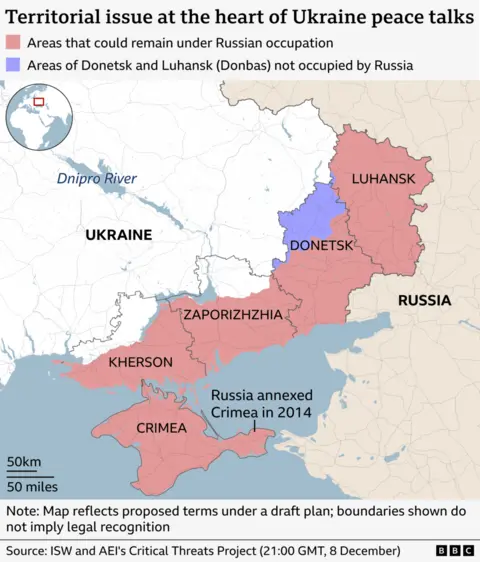Pelosi Long Resisted Stock-Trading Ban for Congress, Fueling Suspicion

© Haiyun Jiang/The New York Times

© Haiyun Jiang/The New York Times

© Jack Taylor/Reuters

奈顿呼吁英国增强“国家韧性”,以应对来自俄罗斯日益增长的威胁。
奈顿在一次演讲中说:“局势比我职业生涯中所经历的任何时候都更加危险,应对之策不仅仅是加强我们的武装力量。”
奈顿说,国防新时代不仅仅意味着我们的军队和政府加大投入,它意味着我们整个国家都要加大投入。
英国军情六处新任负责人也表示,俄罗斯已将全球推入“不确定时代”。
自2022年2月全面入侵乌克兰以来,俄罗斯已对乌克兰发动了近四年的战争。

据德国广播电台报道:周一,华盛顿与基辅代表之间就乌克兰战争停火问题的谈判在柏林总理府继续进行。德国外长瓦德富尔对昨天开始的会谈作出了积极评价。他表示,会谈从未像现在这样严肃认真。他还表示,如果此前的相关报道属实——即泽连斯基总统不再坚持乌克兰加入北约——那么乌克兰已经作出了重大的让步。这将是一个俄罗斯可能接受的提议。
俄方则表示,放弃加入北约是潜在和平解决方案的基石之一。克里姆林宫仍然坚持要求乌克兰割让其东部的顿巴斯地区。周一白天谈判后,晚上,来自多个欧盟成员国以及英国的国家和政府首脑也将出席相关会晤。
据德国《北方信使报》周一傍晚在线报道:据联邦总理默茨介绍,柏林乌克兰和平峰会已取得明显进展——尤其是在为这个遭到俄罗斯攻击的国家提供安全保障方面。“美国在柏林提出的法律和物质层面的保障措施确实令人瞩目,这是一个非常重要的进展,”默茨在与乌克兰总统弗拉基米尔·泽连斯基共同举行的新闻发布会上表示。但他并未透露具体细节。
然而,在最为棘手的一个问题——乌克兰向侵略者俄罗斯割让领土——方面,并未出现任何明显的进展。泽连斯基表示,交战方在这一问题上仍然存在“不同立场”。他说:“我认为领土问题是令人痛苦的。我们百分之百清楚俄罗斯想要什么。”
德国N-TV电视台表示:美国代表团方面虽已表示,90%的争议问题已经解决,但柏林谈判将取得怎样的结果仍不明朗。不过,有一位赢家已然确定:德国总理弗里德里希·默茨(FriedrichMerz)——乌克兰与美国会谈的东道主与发起者。他使中等强国又成为引领者。默茨是推动将超过2000亿欧元的冻结俄罗斯国家资产用于乌克兰的关键力量——这一决定在法律和政治上都极为复杂。尽管如此,欧盟峰会仍可能在本周四作出决定。默茨周一在柏林表示,欧盟必须这样做:这是欧盟的一个关键问题。如果不能成功,欧盟就向世界表明,“在我们历史如此关键的时刻,我们无法团结一致、采取行动,来捍卫我们自己的政治秩序(……)”。默茨所推动的这一决定不仅会加大对俄罗斯的压力,同时也会向特朗普表明,欧洲不会被他牵着鼻子走:在最初的28点方案中,美国曾要求获得这笔资金的一半使用权。目前决定尚未作出——尤其是比利时,因大量俄罗斯资金存放于其境内,而担心遭到俄方报复。如何处置这些被冻结的俄罗斯数十亿资金,预计也将成为周一晚间总理府讨论的议题。这次会晤也被视为对乌克兰的声援行动。“柏林目前正处在一系列极其重要的外交会谈与决策的中心,”泽连斯基在周一下午的德乌经济论坛上表示。他感谢欧洲的团结,也感谢默茨的支持。显而易见的是:没有前者,就不会有后者。
《柏林晨报》表示:美国和乌克兰代表正在柏林就一项和平计划进行谈判。这对东道主默茨而言是一项成功,但仍有许多问题悬而未决。默茨对周日开始的国际会谈感到满意。这些会谈能够得以举行,默茨功不可没。

据德国政府发布的一份声明,欧洲主要国家和欧盟领导人周一提议在乌克兰组建一支“多国部队”,并向兵力上限为80万的乌克兰军队提供“可持续”支持。这支“乌克兰多国部队”将“由有意愿的国家出兵,并得到美国的支持”。
根据德国、法国、英国、丹麦、荷兰、芬兰、挪威、意大利、波兰、瑞典和欧盟领导人签署的文件,这些官员与美国同意“共同努力,在结束战争的协议框架内,为乌克兰提供强有力的安全保障和支持经济复苏的措施”。
这将包括“支持乌克兰扩充自己的武装力量,使其在和平时期保持80万人的兵力水平”。他们还提到“由美国主导的停火监督和核查机制”。
这份文件强调,“现在俄罗斯必须接受特朗普总统的和平计划,以此展现他们致力于实现持久和平的意愿。”
同一份文件还指出,莫斯科必须“接受停火协议,以此展现其结束冲突的决心。”

特朗普在周一于白宫出席活动是表示,协议达成已是“近在咫尺”,并说俄乌双方领导人“一会儿想结束战争,一会儿又反悔”,因此美国需要让双方重回谈判桌,达成共识以取得实质进展。
“我认为我们现在比以往任何时候都更接近(达成协议)目标。”特朗普说,“我们得到了欧洲领导人的大力支持。他们也希望结束这场冲突。”
根据美国官员说法,该方案提供所谓“类似第五条”的安全保障,参考北约集体防御条款精神,透过法律与实质层面的承诺,吓阻俄罗斯再度侵略。
此次谈判于周一在柏林进行,气氛相对乐观。美国特使威特科夫(Steve Witkoff)与美国总统特朗普(Donald Trump)女婿兼顾问库什纳(Jared Kushner)代表白宫出席,与乌克兰总统泽连斯基(Volodymyr Zelenskiy)及其团队、欧洲多国官员展开两天会谈。美方官员透露,特朗普计划周一晚间以电话方式加入欧洲领袖晚宴,与北约秘书长吕特(Mark Rutte)及欧盟委员会主席冯德莱恩(Ursula von der Leyen)等人讨论协议进展。
目前,关于乌克兰的领土争议仍是谈判最大障碍。知情人士透露,美方在讨论中支持俄罗斯要求,主张乌克兰自东部顿巴斯地区撤军,尽管俄军自2014年以来始终未能完全控制该区。泽连斯基多次拒绝此一要求,并与欧洲盟友共同主张,停火线应维持在现有接触线上。他说:“我们正努力让我们的立场被清楚理解。”
即便如此,特朗普政府官员仍认为进展显著。一名官员评估,美俄乌之间约九成议题已获解决,剩余的症结集中在领土让步。美方提出多个“发人深省”的构想,包括设立“经济自由区”,以协助化解僵局,但细节尚未定案。
安全保障方案在会谈中被进一步细化。美方官员指出,该机制将涵盖吓阻俄罗斯再次侵略的安排、建立冲突降级机制,以及对未来和平协议的监督,但不包括美军直接进驻乌克兰。协议亦将明定俄罗斯若违反承诺须承担的后果。一名官员形容:“这是他们见过最强而有力的一套安全规范,是非常、非常强的方案。”
此外,特朗普愿意将这套美国支持的安全保障提交国会审议,被另一名官员称为华盛顿能提供的“白金标准”。美方并表示,相信莫斯科最终可接受该安排,且俄方已释出讯号,对乌克兰加入欧盟持开放态度。
不过,美国媒体“政客”(Politico)以及CNN都引述消息称,特朗普政府所提出的协议并不是“永远有效”,暗示这次“慷慨”的提议可能是来自特朗普的最后通牒,俄乌双方应加快谈判步伐。

北约条约第五条是冷战时期建立的北大西洋公约组织的基石,规定了在联盟成员国遭受攻击时相互援助的原则。实际上,这个条款将相关国家置于美国的军事保护之下,包括核保护。
法新社报道,这位官员在新闻发布会上强调,“我们认为乌克兰人民需要的一切安全保障都包含在协议草案的安全条款中”。
在美国,这些安全保障需要美国参议院投票表决才能通过。
俄罗斯这边,法新社说,要求匿名的美国资深官员和谈判代表认为,俄罗斯“会接受”这些安全保障。安全保障问题对莫斯科来说极其敏感,之前俄罗斯一直断然拒绝乌克兰加入北约。
领土问题上, 美国高级官员还声称,尽管乌克兰总统泽连斯基表示乌克兰和美国在这一问题上立场不同,但会谈期间领土问题取得了进展。
乌克兰谈判团队包括泽连斯基总统在内。
据这两位消息人士透露,特朗普准备在星期一于柏林举行的晚宴期间致电乌克兰总统泽连斯基和欧洲领导人。

© Eric Lee for The New York Times
经过墙体修缮、抢险加固、周边环境整治等工作,北京平谷将军关长城将对外开放。
据新华社报道,北京市文物局介绍,平谷区正积极推动长城保护和开放利用,将军关长城预计最快于2026年底对外开放。
长城北京段依托燕山和太行山山脉分布,延绵500余公里,从东至西横跨平谷、密云、怀柔、延庆、昌平和门头沟等区,以明代长城为主体。北京平谷区的长城资源丰富,包含早期长城遗存和明长城遗存200多处,全长超过50公里。其中,将军关原称将军石关,是明代万里长城进入北京段东端的第一座重要关口,历史上为咽喉要道,是兵家必争之地。
平谷区文物管理所副所长石强说,将军关长城目前属于未开放段长城,符合条件后对外开放将有利于文物历史价值的阐释和展示。在保护长城本体风貌的基础上,工作人员近期对将军关长城周边进行了杂草清理、碎石步道铺设等工作。
北京市文物局遗产管理处处长毕建宇说,推动长城点段开放、将长城点段辟为参观游览区,是传承文化遗产的重要方式。近年来,北京部分开放段长城通过挖掘历史文化内涵,开展夜游、研学游等推动文旅融合,将长城资源禀赋转化为发展优势。

© Christopher Leaman

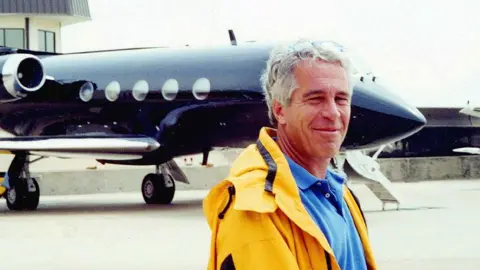 US Department of Justice/PA
US Department of Justice/PAAlmost 90 flights linked to Jeffrey Epstein arrived at and departed from UK airports, some with British women on board who say they were abused by the billionaire, a BBC investigation has found.
We have established that three British women who were allegedly trafficked appear in Epstein's records of flights in and out of the UK and other documents related to the convicted sex offender.
US lawyers representing hundreds of Epstein victims told the BBC it was "shocking" that there has never been a "full-scale UK investigation" into his activities on the other side of the Atlantic.
The UK was one of the "centrepieces" of Epstein's operations, one said.
Testimony from one of these British victims helped convict Epstein's accomplice Ghislaine Maxwell of child sex-trafficking in the US in 2021. But the victim has never been contacted by UK police, her Florida-based lawyer Brad Edwards told the BBC.
The woman, given the name Kate in the trial, was listed as having been on more than 10 flights paid for by Epstein in and out of the UK between 1999 and 2006.
The BBC is not publishing further details about the women in the documents because of the risk this might identify them.
US lawyer Sigrid McCawley said the British authorities have "not taken a closer look at those flights, at where he was at, who he was seeing at those moments, and who was with him on those planes, and conducted a full investigation".

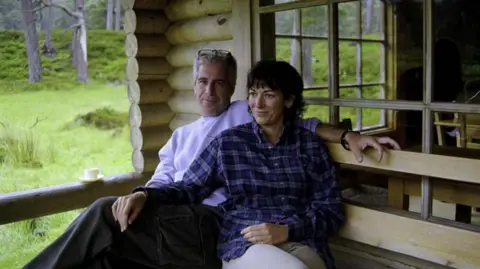 US Attorney's Office SDNY
US Attorney's Office SDNYUnder the Jeffrey Epstein Transparency Act, the deadline to release all US government files on the sex-offender financier is Friday.
But the flight logs were among thousands of documents from court cases and Epstein's estate which have been already made public over the past year, revealing more about his time in the UK, such as trips to royal residences.
The BBC examined these documents as part of an investigation trying to piece together Epstein's activities in the UK.
It revealed that:
Although Epstein died in jail in 2019, before his trial on charges of trafficking minors for sex, legal experts have told the BBC a UK investigation could reveal whether British-based people enabled his crimes.
Two months ago the BBC sent the Metropolitan Police, which has previously examined allegations about Epstein's activities in Britain, publicly available information about the UK flights with suspected trafficking victims on board.
Later, we sent the Met a detailed list of questions about whether it would investigate evidence of possible British victims of Epstein trafficked in and out of the UK.
The Met did not respond to our questions. On Saturday, it released a broader statement saying that it had "not received any additional evidence that would support reopening the investigation" into Epstein and Maxwell's trafficking activities in the UK.
"Should new and relevant information be brought to our attention", including any resulting from the release of material in the US, "we will assess it", the Met said.


US lawyer Brad Edwards, who has been representing Epstein victims since 2008, told us "three or four" of his clients are British women "who were abused on British soil both by Jeffrey Epstein and others".
Other victims were recruited in the UK, trafficked to the United States and abused there, he said.
Mr Edwards said he is also representing women of other nationalities who say they were trafficked to the UK for abuse by Epstein and others.
Our analysis shows Epstein used commercial and chartered flights, as well as his private planes, to travel to the UK and to arrange transport for others, including alleged trafficking victims.
More than 50 of the flights involved his private jets, mostly flying to and from Luton Airport, with several flights at Birmingham International Airport, and one arrival and departure each at RAF Marham in west Norfolk and at Edinburgh Airport.
Limited records of commercial and chartered flights taken by Epstein, or paid for by him, show dozens more journeys, mainly via London Heathrow, but also Stansted and Gatwick.
In a number of the logs of Epstein's private planes, including some detailing trips to the UK, women on the flight are identified only as unnamed "females".

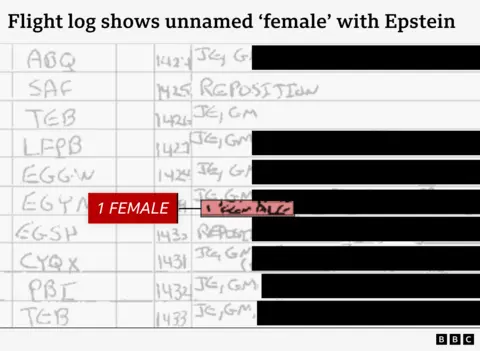
"He's absolutely choosing airports where he feels it will be easier for him to get in and out with victims that he's trafficking," said Ms McCawley.
Private aircraft did not have to provide passenger details to UK authorities before departure in the same way as commercial aircraft during the period covered by the documents we examined. The Home Office told us they were "not subject to the same centralised record-keeping".
That loophole was only closed in April last year.
Kate, the British woman who testified against Maxwell, was on some of the commercial flights in the records we examined. She described in court that she had been 17 when Maxwell befriended her and introduced her to Epstein - who then sexually abused her at Maxwell's central London home.
In the 2021 trial, she described how Maxwell gave her a schoolgirl outfit to wear and asked her to find other girls for Epstein. As well as the dozen flights to and from the UK, Kate told the court she had been flown to Epstein's island in the US Virgin Islands, New York and Palm Beach in Florida, where she says the abuse continued into her 30s.

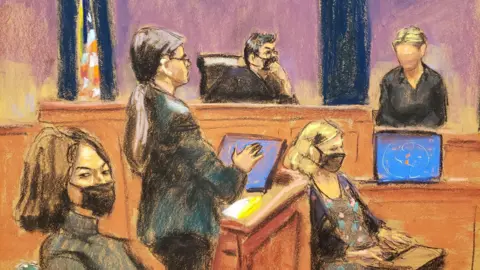 Reuters
ReutersMr Edwards, her lawyer, told BBC News that even after that testimony, Kate has "never been asked" by any UK authorities any questions about her experience - "not even a phone call".
He said that if British police were to launch an investigation into Epstein's activities and his enablers, Kate would be happy to help.
Prof Bridgette Carr, a human-trafficking expert at the University of Michigan Law School, said trafficking cases usually require many people working together.
"It's never just one bad person," she said. "You don't think about the accountant and the lawyer and the banker - or all the bankers - and all these people that had to implicitly, and sometimes explicitly, be OK with what was happening for it to continue."
There are also questions about how Epstein was able to travel freely to the UK after his 2008 conviction for soliciting a minor for sex, which meant he had to register as a sex offender in Florida, New York and the US Virgin Islands.
Epstein was released from prison in 2009 after serving 13 months. Documents suggest Epstein took a Virgin Atlantic flight from the US to London Heathrow in September 2010, just two months after he completed his probation on house arrest.

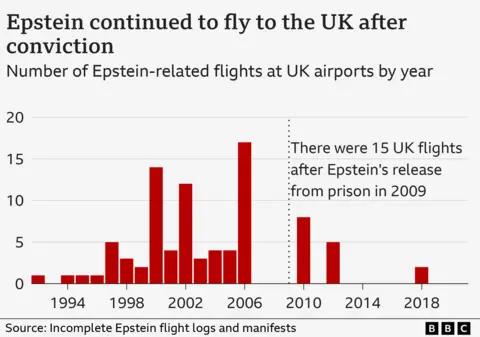
Home Office rules at the time said foreign nationals who received a prison sentence of 12 months or more should, in most cases, have been refused entry.
But immigration lawyer Miglena Ilieva, managing partner at ILEX Law Group, told us that US citizens did not usually require a UK visa for short stays, so there was no application process where they would be asked about criminal convictions.
"It was very much at the discretion of the individual immigration officer who would receive this person at the border," she said.
The Home Office said it does not hold immigration and visa records beyond 10 years and added "it is longstanding government policy that we do not routinely comment on individual cases".
During the 1980s, Epstein also used a foreign passport - issued in Austria with his picture and a false name - to enter the UK as well as France, Spain and Saudi Arabia, according to US authorities.
Epstein also listed London as his place of residence in 1985, when he applied for a replacement passport, ABC News has previously reported.


In its statement on Saturday, the Met said it had contacted "several other potential victims" when it examined 2015 allegations by Virginia Giuffre that she had been trafficked for sexual exploitation by Epstein and Maxwell.
Ms Giuffre also said she was forced to have sex with Andrew Mountbatten-Windsor on three occasions, including when she was 17 at Maxwell's home in London, in 2001. The former prince has consistently denied the allegations against him.
The Met said its examination of Ms Giuffre's claims "did not result in any allegation of criminal conduct against any UK-based nationals" and it concluded that "other international authorities were best placed to progress these allegations".
That decision was reviewed in August 2019 and again in 2021 and 2022 with the same result, it said.
But for lawyer Sigrid McCawley, the message the Met is sending to victims is "that if you come to law enforcement and this is a powerful person you're reporting on… it will not get investigated."

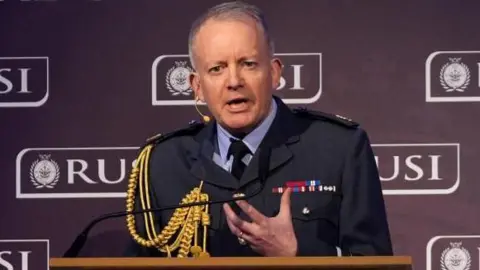 PA Media
PA MediaMore UK families will "know what sacrifice for our nation means" as the nation seeks to deter a potential confrontation with Russia, the head of the military has said.
Sir Richard Knighton said the country's security "cannot be outsourced to the armed forces" and "requires a whole-of-society response", including harnessing UK universities and manufacturing.
While the chief of the defence staff suggested there was only a remote chance of Russia directly attacking the UK, he told an event at the Royal United Services Institute that so-called hybrid attacks showed the threat was worsening.
He referenced a Russian spy ship that was recently suspected of mapping undersea cables near UK waters.
"Every day the UK is subject to an onslaught of cyber-attacks from Russia and we know that Russian agents are seeking to conduct sabotage and have killed on our shores," he added.
At the same time, Russia's military had become a "hard power [which] is growing quickly".
While Russia's full-scale invasion of Ukraine had been a strategic failure, he said, "we should be under no illusions that Russia has a massive, increasingly technically sophisticated, and now highly combat-experienced military".
Sir Richard said the UK needed to make itself a "harder target" for hybrid threats and to avoid war.
Building the nation's resilience went beyond strengthening the military and "more people being ready to fight for their country", and included harnessing the UK's universities, energy and manufacturing industries, and the NHS.
It also meant building industrial capacity "to meet the demands in the UK and of our allies to re-stock and re-arm".
"Building this industrial capacity also means we need more people who leave schools and universities to join that industry."
He added that "we need defence and political leaders to explain the importance of the industry to the nation, and we need schools and parents to encourage children and young adults to take up careers in the industry".
Addressing a skills gap highlighted in a recent report by the Royal Academy of Engineering, Sir Richard also talked about the need to work with industry and young people, announcing £50m for new defence technical excellence colleges.
In recent weeks, both France and Germany have outlined plans for voluntary national service.
Last year, the then-Conservative government set out its own compulsory proposals, which Labour dismissed as a gimmick.
Sir Richard, who became chief of the defence staff in September, said he found himself in a position none of his predecessors had: "looking at the prospect of the largest sustained increase in defence spending since the end of the Cold War".
The government announced earlier this year that UK defence and security spending would rise to 5% of GDP by 2035 at the latest.
"Sons and daughters, colleagues, veterans will all have a role to play - to build, to serve, and if necessary, to fight," Sir Richard said. "And more families will know what sacrifice for our nation means.
"That is why it's so important we do explain the changing threat and the need to stay ahead of it."

 Department for Business and Trade
Department for Business and TradeThe UK and South Korea have finalised a trade deal which the government says will create thousands of jobs and bring billions into the British economy.
British industries including pharmaceuticals, car manufacturing, alcohol and financial services are expected to benefit from an extension to the current tariff-free trade on most goods and services.
The deal is the fourth such agreement struck by the Labour government, following deals with the EU, US and India — none of which have had a material impact on the UK's economy so far.
South Korean culture, including music, cosmetics and food, has become much more popular in the UK in recent years.
Trade minister Chris Bryant announced the deal in Samsung's flagship store in London on Monday night, accompanied by his Korean counterpart Yeo Han-koo.
Under the deal, 98% of trade will continue to be tariff free, the same terms that the EU has with South Korea, and which the UK maintained temporarily after Brexit.
The UK's agreement with South Korea was set to expire in January 2026, but the new agreement will protect £2bn of UK exports from an increase in tariffs.
Prime Minister Keir Starmer said the deal was "a huge win for British business".
"This deal making trade even easier between us will help boost the economy - supporting jobs and growth which will be felt all over the country," he said.
Bryant said the deal would give "cast-iron protections to our key industries to speed up economic growth as part of our Plan for Change".
South Korea is the UK's 25th largest trading partner, according to the Department for Business and Trade. In the 12 months to the end of June this year, it accounted for 0.8% of the UK's total trade.
Over that same 12-month period, official figures show UK exports to South Korea fell 16.4% and South Korean exports to the UK fell 10.8%.
South Korea's trade minister told the BBC that South Korea and Britain's economies "are complimentary", and denied that the fall in trade between the nations suggested the relationship wasn't as important as it used to be.

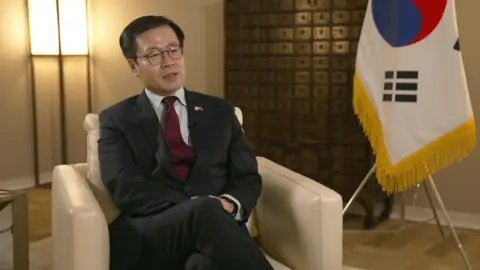
Han-koo said the new agreement was more about reducing non-tariff barriers, such as making rules around product origin more business friendly, and creating new digital and investment protections.
"So these two economies can win by cooperating closer through this kind of framework," he added.
Han-koo also said Britain can serve as a gateway for South Korea in its trade with Europe, while South Korea can serve as a gateway to Asia for British companies.
The South Korean deal is the latest in a series of post-Brexit trade agreements, but the independent budget forecaster, the OBR, has so far deemed deals done with those larger partners as unlikely to make a measurable impact on the UK economy by 2030.
The government has said that its various trade agreements struck this year will grow the British economy by creating jobs and cutting red tape for small businesses.
But its own assessment showed that the deal with India will only increase GDP by between 0.11% and 0.14%.
That deal in particular was criticised for potentially undercutting British workers.
India is the UK's 10th-largest trading partner, accounting for 2.5% of British trade.
UK companies including Bentley Motors, Jaguar Land Rover (JLR) and Guinness owner Diageo welcomed the news of the South Korean deal.
Frank-Steffen Walliser, chairman and chief executive of Bentley Motors, said that South Korea is a key market for the company and the wider luxury vehicle market.
"To secure immediate ongoing access to South Korea and a positive long term trade deal, is great news. Smooth international trade is vital to UK automotive business growth."
Diageo's interim chief executive Nik Jhangiani said it would "help satisfy the growing demand from South Korean consumers" for Guinness, which is canned in Runcorn, Cheshire.
Emily Weaver Roads, interim international director at the Scotch Whisky Association, said the Asia-Pacific region was the largest regional market by value for whisky.
"The reduction of trade barriers in the Republic of Korea will further enhance Scotch Whisky's access to an important market, especially for single malts."
A suspected New Year's Eve terror plot by an extremist group has been foiled by federal authorities in Los Angeles, officials say.
Four alleged members of the Turtle Island Liberation Front - an offshoot of a pro-Palestinian anti-government group - have been arrested on suspicion of planning a coordinated bombing attack in at least five locations across southern California, the FBI and LA law enforcement said on Monday.
The suspects were apprehended last week while traveling to the desert east of Los Angeles to test improvised explosive devices, officials said.
The FBI believes it has "disrupted the plot", but an investigation to identify other potential suspects is ongoing.
US Attorney General Pam Bondi said on X on Sunday that the agencies prevented "far-left" extremists from executing "a massive and horrific terror plot".
Audrey Illeene Carroll, 30; Zachary Aaron Page, 32; Dante Gaffield, 24; and Tina Lai, 41, face charges including conspiracy and possession of an unregistered destructive device, according to the complaint filed in the US District Court for the Central District of California.
On 12 December, the group travelled to the desert with "precursor chemicals" and were allegedly going to create bombs with their wares, officials said during a media conference on Monday.
A surveillance plane captured footage of their movements and the Los Angeles FBI SWAT team, along with the FBI, moved in and arrested the quartet without incident.
The bombing plot involved explosive devices being planted at locations that targeted two US companies described as logistic centres at midnight on New Year's Eve in the Los Angeles area.
The group also allegedly discussed attacking Immigration and Customs Enforcement agents and vehicles with pipe bombs in January or February, according to the complaint said.
Carroll allegedly said: "That would take some of them out and scare the rest of them."
"The successful disruption of this plot is a powerful testament to the strength of our unified response," said LAPD Chief Jim McDonnell, adding that work through allied agencies "prevented a potential tragedy and reaffirmed our shared commitment to safeguarding our communities".

 BBC
BBCAt a meeting of his cabinet at the White House two weeks ago, US President Donald Trump looked around the long room filled with his top advisers, administration officials and aides, and made a prediction.
The next Republican presidential candidate, he said, is "probably sitting at this table".
"It could be a couple of people sitting at this table," he added, hinting at possible electoral clashes to come.
Despite a constitutional amendment limiting him to two four-year terms, his supporters chanted "four more years" at a rally last Tuesday night in Pennsylvania. Trump said at the time that the final three years of his second term amount to an "eternity".
But in the cabinet room last week, when talking about prospects for the 2028 Republican president nomination, he was clear: "It's not going to be me."
The next presidential election may seem a long way off, but Trump's own speculation – and certain frictions within Trump's coalition - suggest that the jockeying to succeed and define the Make America Great Again (Maga) movement after Trump is well under way.

 EPA/Shutterstock
EPA/ShutterstockIn last month's local elections, the Republican Party lost support among the minority and working-class voters who helped Trump win back the White House in 2024.
Members of his team have feuded over policy. And some, most notably Congresswoman Marjorie Taylor Greene, have cut loose from his orbit, accusing the president of losing touch with the Americans who gave him power.
There has been speculation about fractures within the Maga base in certain quarters of the international press, as well as at home. On Monday, a headline in The Washington Post asked: "Maga leaders warn Trump the base is checking out. Will he listen?"
The warning signs are there. While Trump has long been known for being in tune with his base, the months ahead will pose a series of challenges to the president and his movement. Nothing less than his political legacy is at stake.
It was all smiles and talk of historic presidential achievements inside the friendly confines of Trump's newly redecorated, gold-bedecked cabinet room two weeks ago.
But the presidential aspirants Trump may have had in mind as he looked around the table hint at just how hard it could be to keep his Maga movement from stretching apart at the seams.
Vice-President JD Vance sat directly across from the president. As his running mate, he is widely considered to be Trump's most likely heir apparent – the favourite of Trump's sons and libertarian Silicon Valley tech billionaires.

 Getty Images
Getty ImagesSecretary of State Marco Rubio was on the president's immediate right. The former Florida senator, who competed with Trump for the Republican nomination in 2016, had spent the past 10 years undergoing a Maga transformation.
He has jettisoned his past support for liberalising immigration policy and his hard line on Russia in lieu of Trump's America First foreign policy. But if there is anyone close to an old-guard Republican with influence in Trump's party, Rubio tops the list.
Then there is Secretary Robert F Kennedy Jr, whose vaccine scepticism and "Make America Healthy Again" agenda have sent earthquakes through the US health bureaucracy; he sat two down from Rubio. The Democrat-turned-independent-turned-Republican is a living embodiment of the strange ideological bedfellows Trump made on his way to re-election last year.
And finally, Kristi Noem, the homeland security secretary, was tucked off to the corner of the table. While the former South Dakota governor is not considered a major presidential contender, her advocacy for aggressive immigration enforcement – including a recent call for a full travel ban on "every damn country that's been flooding our nation with killers, leeches and entitlement junkies" – has made her a prominent face of administration's policies.

 Reuters
ReutersEach might believe they could, if they chose to run, become Trump's political heir and take control of the political movement that has reshaped American politics over the last decade.
But to paraphrase Benjamin Franklin's comments at the birth of American democracy, whoever wins the Republican nomination will have been given a winning coalition – if they can keep it.
Of course none of this is guaranteed - nor is it certain that the next generation of Maga leaders will be someone from the president's inner circle. Trump stormed the White House as a political outsider. The next Republican leader may follow a similar path.
"It's going to be up to the next Republican president who follows Trump to set him or herself apart," says former Republican Congressman Rodney Davis of Illinois, who now works for the US Chamber of Commerce.
"But at the same time make sure that you don't go too far away, because clearly it's Donald Trump [who] got elected president twice."
When the November 2028 presidential election rolls around, American voters may not even want someone like Trump. Some public opinion polls suggest that the president may not be as popular as he once was.
A survey by YouGov earlier this month indicated the president had a net approval rating of -14, compared with +6 when he took office again in January. Then there are concerns about the economy and his relentless efforts to push the boundaries of presidential power.

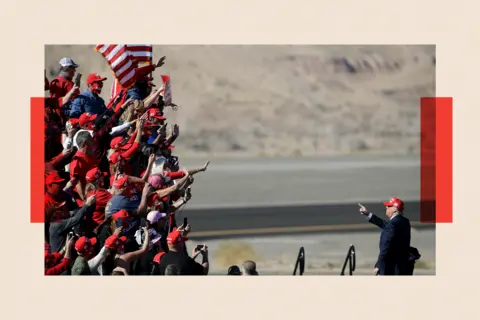 Getty Images
Getty ImagesLeadership of Trump's movement still represents the keys to the Republican empire, however, even if that empire has drastically changed in recent years.
"I think the Republican coalition has become fundamentally different over the last few decades," said Davis, who served in Congress from 2013 to 2023. "The Republican coalition that existed when Ronald Reagan was elected is not the Republican coalition anymore."
Back in the 1980s, the Reagan coalition was a fusion of free-market economics, cultural conservatism, anti-communism and international foreign affairs, says Laura K Field, author of Furious Minds: The Making of the Maga New Right.
Trump's party, she continues, was perhaps best described by long-time Trump adviser and current state department official Michael Anton in a 2016 essay advocating for Trump's election. In contrast with the Reagan era, its core principles include "secure borders, economic nationalism and America-first foreign policy".
Earlier this month, the conservative Manhattan Institute released a comprehensive survey of Republican voters, shedding more light on the composition of Trump's coalition.
It suggested that 65% of the current Republican Party are what it calls "core Republicans" – those who have supported party presidential nominees since at least 2016. (If they were alive in the 1980s, they may well have voted for Reagan.)
On the other hand, 29% are what the Institute called "new entrant Republicans". It is among those new Republicans that the challenge to the durability of Trump's coalition presents itself.
Only just over half said they would "definitely" support a Republican in next year's mid-term congressional elections.
According to the survey, the new entrants are younger, more diverse and more likely to hold views that break with traditional conservative orthodoxy. They hold comparatively more left-leaning views of economic policy, they tend to be more liberal on immigration and social issues, and they may also be more pro-China or critical of Israel, for example.

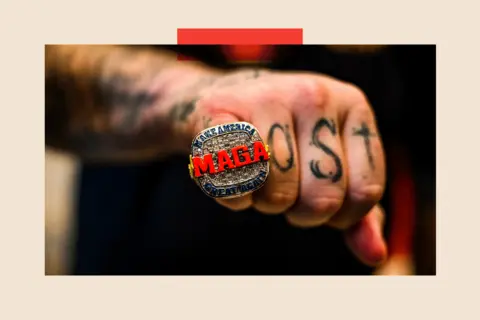 AFP via Getty Images
AFP via Getty ImagesJesse Arm, vice-president of external affairs at the Manhattan Institute, told the BBC in an email: "A lot of the conversation about the future of the right is being driven by the loudest and strangest voices online, rather than by the voters who actually make up the bulk of the Republican coalition."
Perhaps not surprisingly, the so-called new entrant Republican voters are significantly less supportive of some of Trump's would-be heirs. While 70% of core Republicans have positive views of Rubio and 80% for Vance, just over half of new entrants feel that way about either.
Other findings could be more concerning for Republicans.
More than half of new entrants believe the use of political violence in American politics "is sometimes justified" – compared to just 20% among core Republicans.
It also suggests they may be more likely to be tolerant of racist or anti-Semitic speech and more prone to conspiratorial thinking – on topics like the moon landings, 9/11 and vaccines.
Trump was able to attract these voters into his coalition. The question is whether he and his political heirs can keep them there – or if they even want to.
"The real takeaway is not that these voters will 'define' the post-Trump GOP, but that future Republican leaders will have to draw clear lines about who sets the agenda," argues Mr Arm.
"The heart of the party remains normie Republicans, not the edgelords that both the media and the dissident right are strangely invested in elevating."
The divides revealed in the Manhattan Institute poll helps explain some of the most notable frictions within the Trump coalition over the past few months.
The Trump-Greene feud that culminated in the latter's resignation from Congress began with her backing of a full release of the government files connected to the Jeffrey Epstein underage sex-trafficking case – long a source of conservative conspiracy theories.
It broadened, however, into a critique of Trump's Middle East policy and accusations of his failure to address cost-of-living and healthcare concerns for low-income American voters.
An earlier high-profile Maga split erupted over Trump's economic policy, with billionaire Elon Musk, a strong supporter and member of Trump's inner circle at the start of the year, going on to condemn certain tariffs and government spending policies.

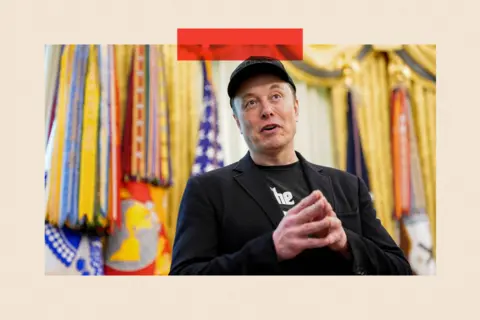 Reuters
ReutersThe president has, for the moment, largely tried to stay out of another bitter clash within conservative ranks over whether Nick Fuentes, a far-right political commentator and Holocaust denier, is welcome within the conservative movement.
It's a dispute that has roiled the influential Heritage Foundation and pitted some powerful right-wing commentators against each other.
According to Ms Field, those who follow Trump may find it a difficult conflict to avoid. "Nick Fuentes has a huge following," she says. "Part of how the conservative movement got the energy and power that they've got is by peddling to this part of the Republican Party."
In the halls of the Republican-controlled Congress, some signs of friction with the president's agenda are showing. Despite White House lobbying, it couldn't stop the House from passing a measure mandating release of the Epstein files.
The president has also been unable to convince Senate Republicans to abandon the filibuster, a parliamentary procedure Democrats in the minority have been able to block some of Trump's agenda.

 AFP via Getty Images
AFP via Getty ImagesMeanwhile, Trump's party has been stumbling at the polls, with the Democrats winning governorships in Virginia and New Jersey last month by comfortable margins.
In dozens of contested special elections for state and local seats over the past year, Democrats have on average improved their margins by around 13% over similar races held in last November's national elections.
All of this will be front of mind for Republicans ahead of the 2026 mid-term congressional elections - and it will do little to ease the concerns held by some that, without Trump at the top of the ticket, their coalition will struggle to deliver reliable ballot-box victories.
Yet even a defeat next year – or in 2028 – is unlikely to mark the end of Trumpism.
The ascent by Trump's Maga movement to the pinnacle of American power has been far from a smooth one. It includes a mid-term rout in 2018 and Trump himself losing in 2020, before his re-election last November.
But the changes that Trump has wrought within the Republican Party itself appear to be foundational ones, according to Ms Field. His Maga coalition builds on strains of populist movements in the US that date back decades or more – from Barry Goldwater's insurgent presidential campaign in 1964 to the Tea Party protests during Barack Obama's presidency.
"These things are not coming out of nowhere. They are forces in American politics that have been underground for a while, but have been just kind of fermenting."
The old Republican order, she argues, is a relic of the past.
"The Trump movement is here to stay and there's no real likelihood of the old establishment returning with any sort of clout - that much is clear."
Top picture credit: Getty Images


BBC InDepth is the home on the website and app for the best analysis, with fresh perspectives that challenge assumptions and deep reporting on the biggest issues of the day. You can now sign up for notifications that will alert you whenever an InDepth story is published - click here to find out how.

 US Department of Justice/PA
US Department of Justice/PAAlmost 90 flights linked to Jeffrey Epstein arrived at and departed from UK airports, some with British women on board who say they were abused by the billionaire, a BBC investigation has found.
We have established that three British women who were allegedly trafficked appear in Epstein's records of flights in and out of the UK and other documents related to the convicted sex offender.
US lawyers representing hundreds of Epstein victims told the BBC it was "shocking" that there has never been a "full-scale UK investigation" into his activities on the other side of the Atlantic.
The UK was one of the "centrepieces" of Epstein's operations, one said.
Testimony from one of these British victims helped convict Epstein's accomplice Ghislaine Maxwell of child sex-trafficking in the US in 2021. But the victim has never been contacted by UK police, her Florida-based lawyer Brad Edwards told the BBC.
The woman, given the name Kate in the trial, was listed as having been on more than 10 flights paid for by Epstein in and out of the UK between 1999 and 2006.
The BBC is not publishing further details about the women in the documents because of the risk this might identify them.
US lawyer Sigrid McCawley said the British authorities have "not taken a closer look at those flights, at where he was at, who he was seeing at those moments, and who was with him on those planes, and conducted a full investigation".

 US Attorney's Office SDNY
US Attorney's Office SDNYUnder the Jeffrey Epstein Transparency Act, the deadline to release all US government files on the sex-offender financier is Friday.
But the flight logs were among thousands of documents from court cases and Epstein's estate which have been already made public over the past year, revealing more about his time in the UK, such as trips to royal residences.
The BBC examined these documents as part of an investigation trying to piece together Epstein's activities in the UK.
It revealed that:
Although Epstein died in jail in 2019, before his trial on charges of trafficking minors for sex, legal experts have told the BBC a UK investigation could reveal whether British-based people enabled his crimes.
Two months ago the BBC sent the Metropolitan Police, which has previously examined allegations about Epstein's activities in Britain, publicly available information about the UK flights with suspected trafficking victims on board.
Later, we sent the Met a detailed list of questions about whether it would investigate evidence of possible British victims of Epstein trafficked in and out of the UK.
The Met did not respond to our questions. On Saturday, it released a broader statement saying that it had "not received any additional evidence that would support reopening the investigation" into Epstein and Maxwell's trafficking activities in the UK.
"Should new and relevant information be brought to our attention", including any resulting from the release of material in the US, "we will assess it", the Met said.


US lawyer Brad Edwards, who has been representing Epstein victims since 2008, told us "three or four" of his clients are British women "who were abused on British soil both by Jeffrey Epstein and others".
Other victims were recruited in the UK, trafficked to the United States and abused there, he said.
Mr Edwards said he is also representing women of other nationalities who say they were trafficked to the UK for abuse by Epstein and others.
Our analysis shows Epstein used commercial and chartered flights, as well as his private planes, to travel to the UK and to arrange transport for others, including alleged trafficking victims.
More than 50 of the flights involved his private jets, mostly flying to and from Luton Airport, with several flights at Birmingham International Airport, and one arrival and departure each at RAF Marham in west Norfolk and at Edinburgh Airport.
Limited records of commercial and chartered flights taken by Epstein, or paid for by him, show dozens more journeys, mainly via London Heathrow, but also Stansted and Gatwick.
In a number of the logs of Epstein's private planes, including some detailing trips to the UK, women on the flight are identified only as unnamed "females".


"He's absolutely choosing airports where he feels it will be easier for him to get in and out with victims that he's trafficking," said Ms McCawley.
Private aircraft did not have to provide passenger details to UK authorities before departure in the same way as commercial aircraft during the period covered by the documents we examined. The Home Office told us they were "not subject to the same centralised record-keeping".
That loophole was only closed in April last year.
Kate, the British woman who testified against Maxwell, was on some of the commercial flights in the records we examined. She described in court that she had been 17 when Maxwell befriended her and introduced her to Epstein - who then sexually abused her at Maxwell's central London home.
In the 2021 trial, she described how Maxwell gave her a schoolgirl outfit to wear and asked her to find other girls for Epstein. As well as the dozen flights to and from the UK, Kate told the court she had been flown to Epstein's island in the US Virgin Islands, New York and Palm Beach in Florida, where she says the abuse continued into her 30s.

 Reuters
ReutersMr Edwards, her lawyer, told BBC News that even after that testimony, Kate has "never been asked" by any UK authorities any questions about her experience - "not even a phone call".
He said that if British police were to launch an investigation into Epstein's activities and his enablers, Kate would be happy to help.
Prof Bridgette Carr, a human-trafficking expert at the University of Michigan Law School, said trafficking cases usually require many people working together.
"It's never just one bad person," she said. "You don't think about the accountant and the lawyer and the banker - or all the bankers - and all these people that had to implicitly, and sometimes explicitly, be OK with what was happening for it to continue."
There are also questions about how Epstein was able to travel freely to the UK after his 2008 conviction for soliciting a minor for sex, which meant he had to register as a sex offender in Florida, New York and the US Virgin Islands.
Epstein was released from prison in 2009 after serving 13 months. Documents suggest Epstein took a Virgin Atlantic flight from the US to London Heathrow in September 2010, just two months after he completed his probation on house arrest.


Home Office rules at the time said foreign nationals who received a prison sentence of 12 months or more should, in most cases, have been refused entry.
But immigration lawyer Miglena Ilieva, managing partner at ILEX Law Group, told us that US citizens did not usually require a UK visa for short stays, so there was no application process where they would be asked about criminal convictions.
"It was very much at the discretion of the individual immigration officer who would receive this person at the border," she said.
The Home Office said it does not hold immigration and visa records beyond 10 years and added "it is longstanding government policy that we do not routinely comment on individual cases".
During the 1980s, Epstein also used a foreign passport - issued in Austria with his picture and a false name - to enter the UK as well as France, Spain and Saudi Arabia, according to US authorities.
Epstein also listed London as his place of residence in 1985, when he applied for a replacement passport, ABC News has previously reported.


In its statement on Saturday, the Met said it had contacted "several other potential victims" when it examined 2015 allegations by Virginia Giuffre that she had been trafficked for sexual exploitation by Epstein and Maxwell.
Ms Giuffre also said she was forced to have sex with Andrew Mountbatten-Windsor on three occasions, including when she was 17 at Maxwell's home in London, in 2001. The former prince has consistently denied the allegations against him.
The Met said its examination of Ms Giuffre's claims "did not result in any allegation of criminal conduct against any UK-based nationals" and it concluded that "other international authorities were best placed to progress these allegations".
That decision was reviewed in August 2019 and again in 2021 and 2022 with the same result, it said.
But for lawyer Sigrid McCawley, the message the Met is sending to victims is "that if you come to law enforcement and this is a powerful person you're reporting on… it will not get investigated."

法国参议院通过2026年国家预算草案,文本将提交参众两院组成的联合委员会审议。
法国参议院于12月15日(周一)一读通过了经过修改的2026年法国国家预算草案。投票的结果是187票赞成、109票反对。接下来,该草案将提交给由参众两院议员组成的联合委员会(commission mixte paritaire)审议,这一联合委员会将于12月19日星期五召开会议,试图达成一致。
法国参议院周一通过的预算案文本是在主导参议院的右翼和中间派联盟的推动下重新调整过的。而法国国民议会在此前几周的一读表决中否决了这一预算案。
如果联合委员会的成员们(CMP)能够达成妥协的话,那么,他们形成的文本将于下周提交给两院表决,以期最终通过。如果联合委员会的成员们无法达成一致,预算的辩论可能将延续至明年1月份,那么,届时,就需要通过一项特别的法案,以确保国家能够连续运转。
本周对法国总理勒科尔尼来说至关重要。勒科尔尼在9月份时承诺,要在不动用宪法第49.3条的情况下通过预算案,目前仍坚持这一立场。
在社保预算案方面,法国总理的这一策略几乎已经成功了:社保预算已于上周在国民议会以微弱的优势获得通过。议员们将于12月16日(周二)就社保预算案进行最后一次表决。现在就看这一策略是否也能在国家预算案上奏效。

© Haiyun Jiang/The New York Times
香港法院裁定,壹传媒集团创办人黎智英三项国安罪名皆成立,中国外交部驻港公署称“正义审判不容置喙,外部干预注定失败”。
据中新社报道,外交部驻港公署发言人星期一(12月15日)说,坚决支持香港特区依法裁决黎智英串谋勾结外部势力危害国家安全罪及串谋发布煽动刊物罪等罪名成立。针对英国、澳大利亚、美国、德国等国家、欧盟及个别政客就此定罪裁决说三道四、公然干预抹黑香港司法,表示强烈不满和坚决反对,予以严厉谴责。
发言人称,香港是法治社会,法律面前人人平等,没有任何人拥有凌驾于法律之上的特权。黎智英是反中乱港事件的主要策划者和参与者,是外部反华势力的“代理人”和“马前卒”,其言行严重危害国家安全。香港特区司法机关依法履职尽责,维护法律权威,捍卫国家安全,合情合理合法,不容置喙。黎案与“新闻自由”毫无关系。任何企图为黎洗白、通过政治施压干预司法的行径,都是对法治精神的公然践踏。
发言人称,个别国家和政客,长期以来打着“人权”“自由”幌子抹黑香港法治,妄图破坏香港繁荣稳定、干涉中国内政。当他们执行维护自身国家安全的法律时,他们称之为“捍卫法治”;而当香港特区依法采取同等性质行动时,却被污蔑为“压制自由”。这种典型的双重标准,充分暴露其虚伪面目和险恶用心。
发言人称,有关司法案件纯属香港特区内部事务,不容干涉。有关国家和政客的拙劣表演阻挡不了香港由治及兴的历史大势,虚张声势的制裁威胁注定徒劳无功。中方敦促有关国家和政客认清现实、悬崖勒马,立即停止干预香港事务和中国内政。
78岁的黎智英是已停刊的《苹果日报》创办人,2020年8月涉违反《香港国安法》被捕。案件于2023年12月开审,经过156天审讯,今年8月完成聆讯。
香港法院星期一公布裁决,裁定黎智英两项串谋勾结外国或境外势力危害国家安全罪,以及一项串谋发布煽动刊物罪,罪名全部成立。
黎智英定罪后,数国政府和国际组织予以谴责。英国外长顾绮慧(Yvette Cooper)指,黎智英因和平行使言论自由权利而成打压对象,呼吁立即释放黎智英。澳大利亚政府也发声明,对黎智英被定罪表达关切。

© Mohammed Jamal/Reuters


© Alex Brandon/AP

© ABC Photo Archives/Disney

 Getty Images
Getty ImagesA son of film director Rob Reiner and Michele Singer Reiner has been arrested and booked on suspicion of murder after the couple were found dead in their Los Angeles home.
The Los Angeles Police Department said on Monday that Nick Reiner, 32, had been arrested and that he was in custody with no bail.
The deceased couple's 28-year-old daughter, Romy, found her parents in their home with multiple stab wounds on Sunday, sources told the BBC's US partner CBS News.
Rob Reiner is known for directing several iconic films in a variety of genres, including When Harry Met Sally, This is Spinal Tap, Stand By Me, Misery and A Few Good Men.
Emergency services were called to provide medical aid at the Reiners' Brentwood, California, home at around 15:38 local time (23:38 GMT) on Sunday.
The Los Angeles Fire Department said two people - later identified as Rob Reiner, 78, and his wife Michele, 68 - were pronounced dead at the scene.
Police said Nick Reiner was arrested several hours later, at about 21:15 local time on Sunday. Investigators have not publicly outlined a motive and said the investigation remains ongoing.

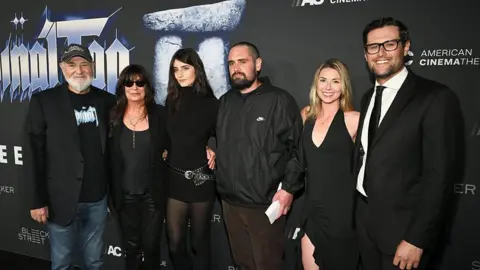 Getty Images
Getty ImagesNick Reiner has spoken publicly about his struggles with addiction and homelessness. His experiences formed the basis of the semi-autobiographical film Being Charlie, which he made with his father in 2015.
The family's home is in Brentwood, a wealthy celebrity enclave full of large mansions, boutique shops and restaurants. On Monday morning, a security guard stood outside the home as media gathered outside the front gate.
Rob Reiner, the son of comedy great Carl Reiner, began his career in the 1960s and rose to fame playing Meathead in the TV sitcom All in The Family.
He cemented his success with the cult mockumentary This Is Spinal Tap in 1984, which he directed and starred in.
Reiner was married to Laverne & Shirley actress Penny Marshall from 1971 to 1981 and is the adoptive father to Marshall's daughter, actress Tracy Reiner.
He married Michele Reiner in 1989, who he said he met during the making of the romantic comedy-drama film When Harry Met Sally. The couple have three children together.

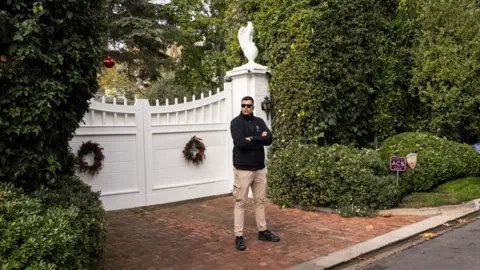 EPA
EPAMichele Reiner was an actress, photographer and producer, and the founder of Reiner Light, a photography agency and production company.
Rob Reiner was also known for his outspoken political activism and support for Democratic candidates.
In a post calling their deaths "very sad", President Donald Trump criticised Reiner, saying that they "reportedly" died "due to the anger he caused others through his massive, unyielding, and incurable affliction" with "Trump Derangement Syndrome".
"He was known to have driven people CRAZY by his raging obsession of President Donald J. Trump," the president wrote.
It is not clear what reports the president was referring to, and while the investigation is being treated as a homicide, police have yet to comment on any possible motive.
The president and his allies often used the term Trump Derangement Syndrome in reference to those who are critical of him. Reiner was a vocal critic of Trump's.
Several Republicans criticised Trump over the post, including former ally Marjorie Taylor Greene, who said the deaths were a "family tragedy, not about politics or political enemies".
"Many families deal with a family member with drug addiction and mental health issues. It's incredibly difficult and should be met with empathy especially when it ends in murder," she said.
Trump's post was also met with anger by some of the Reiners' friends.
In a post on X, Maria Shriver, the former first lady of California and longtime friend of the Reiners, said the couple were "devoted parents".
"They deeply loved all their children and they never gave up trying to care for them," she said.
Sir Elton John, who made an appearance in this year's Spinal Tap sequel, said: "I am in disbelief at today's news of Rob and Michele.
"They were two of the most beautiful people I'd ever met and they deserved better."
Fellow actor John Cusack, who appeared in Reiner's 1985 film The Sure Thing, called him "a great man", while Elijah Wood, who starred in 1994's North, said he was "horrified" by the couple's deaths.

Cameron Menzies was pictured with blood on his right hand as he left the stage
Cameron Menzies has apologised for angrily punching a drinks table after his five-set defeat by Charlie Manby in the first round of the PDC World Championship.
The 26th seed from Scotland hit the underside of the table three times before holding his hand up in apology to the Alexandra Palace crowd as he left the stage.
Menzies, 36, was pictured with blood pouring from a gash on his right hand.
He had led 1-0 and 2-1 in sets before highly rated English debutant Manby, 20, fought back and clinched victory with his seventh match dart.
In a statement released after the match, Menzies said: "First of all, I would like to apologise for what happened. I am sorry that I reacted in the manner that I did.
"It's not an excuse, but I have had a lot of things on my mind recently and I suppose it all just became too much at the end.
"It has not been an easy time for me with my uncle Gary passing away recently. I saw him four days before he died and he gave me a look which told me how much he thought of me.
"Had I won the game against Charlie, my second match would have been on the day of Gary's funeral and that hasn't been lost on me.
"Let me say again, that's no excuse for what I did on the stage. It was the wrong thing to do and I don't want it to take anything away from Charlie. He played well.
"This is not how I would like people to view me. Yes, I can get emotional at times, but not like that and that wasn't right."
Professional Darts Corporation chief executive Matt Porter said: "I spoke with Cameron and his management before he left the venue, and he knows there is support available from the PDC and the PDPA [Professional Darts Players Association].
"Any incident of this nature is reported to the Darts Regulation Authority for review, but our main priority is the player's health and wellbeing."
It is the second year running that Menzies has been knocked out in the first round, after he broke down in tears during and following his exit to Leonard Gates last December.
Menzies later revealed his father Ricky had been ill in hospital at the time.

Menzies was directed off stage by the referee after punching a drinks table

Menzies held his hand up in apology to the crowd when leaving the stage
Players can be sanctioned under Darts Regulation Authority rules for aggressive, disruptive or abusive behaviour.
Former World Championship semi-finalist Wayne Mardle said on Sky Sports: "The frustration boiled over, the anger and the anguish of losing, but you've got to control that. That's what conducting yourself in the right way is all about.
"He let himself down and I'm sure he'll be punished accordingly by the Darts Regulation Authority, but hopefully the Professional Darts Players Association are there for him.
"You've got to control yourself and he didn't and you can't do that anywhere, let alone on the biggest stage of them all. I hope he can correct his behaviour and move forward."
Also in Monday's afternoon session, two-time champion Peter Wright made it through to round two with a straight-set win over Noa-Lynn van Leuven.
The 55-year-old Scot, wearing a festive-themed outfit, landed a 152 checkout in the first set and was taken to a deciding leg in the second, before closing out victory comfortably in the third.
Wright, who will face German Arno Merk in round two, told Sky Sports: "I know I didn't play well but I will play well in the next round. You've got to grow into the tournament."
Wright, the winner in 2020 and 2022, has struggled for form in recent times and has slipped to 30th in the PDC world rankings as a result.
He reached the quarter-finals last year, ending Luke Humphries' title defence on his way to the last eight before losing to Stephen Bunting.

Peter Wright hit nine of his 16 attempts at doubles during his first-round victory
Van Leuven, who became the first transgender player to appear at the PDC World Championship last year, was one of five players from the Women's Series to qualify for the event at Alexandra Palace.
Beau Greaves topped the series and faces Daryl Gurney first on Friday as she looks to become only the second female player to win a match in the tournament, after fellow qualifier Fallon Sherrock, who won twice at the event in December 2019.
Three places were on offer from the series, along with a spot for the Women's Matchplay winner - a title taken by Lisa Ashton, who lost to 2023 world champion Michael Smith in the first round on Thursday.
With Greaves qualifying in her own right as runner-up on the Development Tour, that meant Women's Series runner-up Sherrock, Van Leuven in fourth and Gemma Hayter, who finished fifth, joined third-placed Ashton.
Northern Ireland's Brendan Dolan hit a 170 checkout to seal the second set in his 3-1 victory over England's Tavis Dudeney, while Austria's Mensur Suljovic beat Canada's David Cameron by the same scoreline.
World Darts Championship 2026 schedule and results
World Darts Championship - Draw, seeds, prize money
Brendan Dolan 3-1 Tavis Dudeney
Cameron Menzies 2-3 Charlie Manby
Mensur Suljovic 3-1 David Cameron
Peter Wright 3-0 Noa-Lynn van Leuven
From 19:00 GMT
Martin Lukeman v Max Hopp
Dirk van Duijvenbode v Andy Baetens
Jonny Clayton v Adam Lipscombe
Connor Scutt v Simon Whitlock
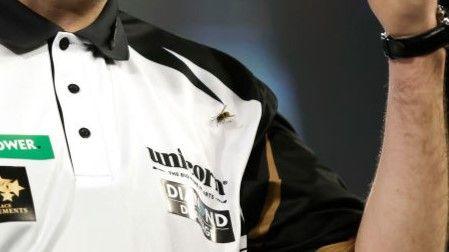


 Getty Images
Getty ImagesA son of film director Rob Reiner and Michele Singer Reiner has been arrested and booked on suspicion of murder after the couple were found dead in their Los Angeles home.
The Los Angeles Police Department said on Monday that Nick Reiner, 32, had been arrested and that he was in custody with no bail.
The deceased couple's 28-year-old daughter, Romy, found her parents in their home with multiple stab wounds on Sunday, sources told the BBC's US partner CBS News.
Rob Reiner is known for directing several iconic films in a variety of genres, including When Harry Met Sally, This is Spinal Tap, Stand By Me, Misery and A Few Good Men.
Emergency services were called to provide medical aid at the Reiners' Brentwood, California, home at around 15:38 local time (23:38 GMT) on Sunday.
The Los Angeles Fire Department said two people - later identified as Rob Reiner, 78, and his wife Michele, 68 - were pronounced dead at the scene.
Police said Nick Reiner was arrested several hours later, at about 21:15 local time on Sunday. Investigators have not publicly outlined a motive and said the investigation remains ongoing.

 Getty Images
Getty ImagesNick Reiner has spoken publicly about his struggles with addiction and homelessness. His experiences formed the basis of the semi-autobiographical film Being Charlie, which he made with his father in 2015.
The family's home is in Brentwood, a wealthy celebrity enclave full of large mansions, boutique shops and restaurants. On Monday morning, a security guard stood outside the home as media gathered outside the front gate.
Rob Reiner, the son of comedy great Carl Reiner, began his career in the 1960s and rose to fame playing Meathead in the TV sitcom All in The Family.
He cemented his success with the cult mockumentary This Is Spinal Tap in 1984, which he directed and starred in.
Reiner was married to Laverne & Shirley actress Penny Marshall from 1971 to 1981 and is the adoptive father to Marshall's daughter, actress Tracy Reiner.
He married Michele Reiner in 1989, who he said he met during the making of the romantic comedy-drama film When Harry Met Sally. The couple have three children together.

 EPA
EPAMichele Reiner was an actress, photographer and producer, and the founder of Reiner Light, a photography agency and production company.
Rob Reiner was also known for his outspoken political activism and support for Democratic candidates.
In a post calling their deaths "very sad", President Donald Trump criticised Reiner, saying that they "reportedly" died "due to the anger he caused others through his massive, unyielding, and incurable affliction" with "Trump Derangement Syndrome".
"He was known to have driven people CRAZY by his raging obsession of President Donald J. Trump," the president wrote.
It is not clear what reports the president was referring to, and while the investigation is being treated as a homicide, police have yet to comment on any possible motive.
The president and his allies often used the term Trump Derangement Syndrome in reference to those who are critical of him. Reiner was a vocal critic of Trump's.
Several Republicans criticised Trump over the post, including former ally Marjorie Taylor Greene, who said the deaths were a "family tragedy, not about politics or political enemies".
"Many families deal with a family member with drug addiction and mental health issues. It's incredibly difficult and should be met with empathy especially when it ends in murder," she said.
Trump's post was also met with anger by some of the Reiners' friends.
In a post on X, Maria Shriver, the former first lady of California and longtime friend of the Reiners, said the couple were "devoted parents".
"They deeply loved all their children and they never gave up trying to care for them," she said.
Sir Elton John, who made an appearance in this year's Spinal Tap sequel, said: "I am in disbelief at today's news of Rob and Michele.
"They were two of the most beautiful people I'd ever met and they deserved better."
Fellow actor John Cusack, who appeared in Reiner's 1985 film The Sure Thing, called him "a great man", while Elijah Wood, who starred in 1994's North, said he was "horrified" by the couple's deaths.

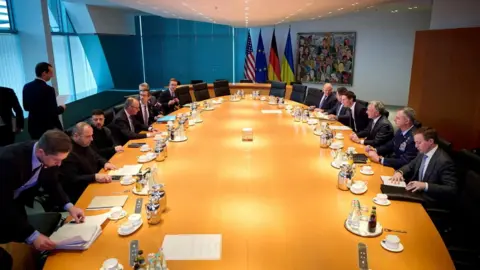 Reuters
ReutersTalks between Ukraine and the US aimed at reaching a peace deal with Russia are continuing in Berlin for a second day.
Zelensky and his chief negotiator Rustem Umerov met US envoy Steve Witkoff and Donald Trump's son-in-law Jared Kushner for five hours on Sunday, joined by German Chancellor Friedrich Merz.
"A lot of progress was made," a US readout said. The same team resumed talks on Monday morning.
Ahead of the start of the meeting, Volodymyr Zelensky signalled he would give up ambitions to join Nato in exchange for security guarantees.
Recognising that "some partners from the US and Europe" did not support Ukraine's bid for Nato membership, Zelensky said he was instead seeking strong security guarantees modelled on Nato's Article 5 clause of mutual protection.
"And this is already a compromise on our part," he said on Sunday.
Witkoff has travelled to Moscow to hold talks with Vladimir Putin on several occasions, but Sunday's meeting at the chancellery in Berlin was the first time he met Zelensky. Nato Supreme Allied Commander Europe General Alexus Grynkewich was also present at the talks.
Several European leaders as well as European Commission President Ursula von der Leyen are expected to join further talks with the Ukrainian and US delegations on Monday evening.
At the core of the discussions in Berlin is the 20-point peace plan proposal presented to the US by Ukraine last week to counter an initial American plan which was seen as heavily favouring Russia.
Details haven't been shared, but last week Zelensky said the points should be seen as a "foundation" on which to build provisions for the reconstruction of Ukraine and security guarantees.
For Russia, Kyiv's membership of Nato is a red line, and Moscow has repeatedly demanded that any ambitions for Ukraine to join the alliance are shelved forever. "This issue is one of the cornerstones and requires special discussion," said the Kremlin on Monday.
The US too has repeatedly stated it does not want Ukraine to be part of Nato. But Kyiv fears that a peace deal without watertight security guarantees would fail to detract Russia from attacking again.
Before the talks began, Zelensky also addressed the thorny issue of sovereignty over the eastern region of the Donbas, which Russia mostly occupies and which it wants Kyiv to hand over in their entirety.
The Ukrainian president said that while he was open to freezing the conflict along the current front line he was not prepared to have his troops withdraw from the percentage of the Donbas they still hold - unless Russian forces did the same in the areas they control.
For it to be a fair arrangement Russia would have to withdraw the same distance, Zelensky said. This matter was "extremely sensitive and heated," he added.
Any proposal hashed out by the Ukrainian, American and European side will still have to be presented to Moscow – although Zelensky said that the US delegation "so to speak present the Russian side's perspective, because they relay Russia's signals, demands, steps, and indications of readiness or lack thereof."
The Kremlin said it expected the US to provide us with the "concept" discussed on Monday.
The talks in Berlin come at a crucial time for Ukraine, which is enduring its fourth winter of war amid sustained power cuts caused by Russia's attacks on its energy facilities. Over the weekend more than a million households in Ukraine were left without electricity following a barrage of strikes.
Later this week, EU countries will be voting on a plan to send €90bn (£78.6bn) worth of frozen Russian assets held in a Belgium-based financial institution to prop up Ukraine's economy.
On Friday, EU governments agreed to immobilise the Russian assets indefinitely - but there is no consensus yet on whether they can be sent to Ukraine. Belgium has been resisting the legally contentious proposal, and in recent days other countries, including Italy, have said "alternative options" should be put forward.
EU foreign policy chief Kaja Kallas acknowledged the discussions were "increasingly difficult".
"But we're doing the work, and we still have some days," she added.

